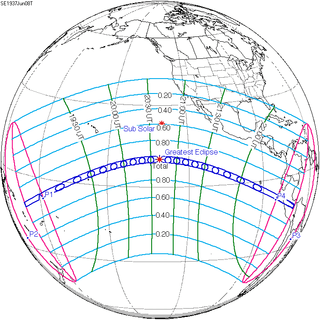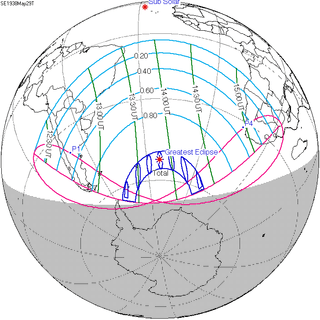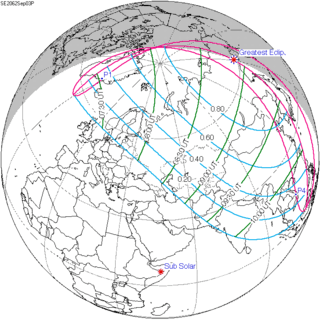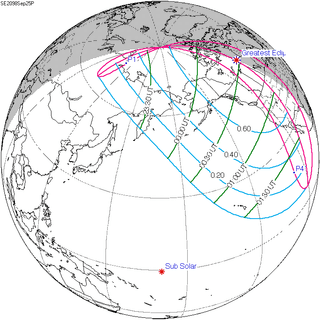Solar eclipse of June 19, 1936
| Solar eclipse of June 19, 1936 | |
|---|---|
 Map | |
| Type of eclipse | |
| Nature | Total |
| Gamma | 0.5389 |
| Magnitude | 1.0329 |
| Maximum eclipse | |
| Duration | 151 sec (2 m 31 s) |
| Coordinates | 56°06′N 104°42′E / 56.1°N 104.7°E |
| Max. width of band | 132 km (82 mi) |
| Times (UTC) | |
| Greatest eclipse | 5:20:31 |
| References | |
| Saros | 126 (43 of 72) |
| Catalog # (SE5000) | 9367 |
A total solar eclipse occurred on June 19, 1936. A solar eclipse occurs when the Moon passes between Earth and the Sun, thereby totally or partly obscuring the image of the Sun for a viewer on Earth. A total solar eclipse occurs when the Moon's apparent diameter is larger than the Sun's, blocking all direct sunlight, turning day into darkness. Totality occurs in a narrow path across Earth's surface, with the partial solar eclipse visible over a surrounding region thousands of kilometres wide. The path of totality crossed Europe and Asia. The full phase can be seen in Greece, Turkey, USSR, China and Japan. The maximum eclipse was near Bratsk and lasts about 2.5 minutes.
Related eclipses
Solar eclipses 1935-1938
Each member in a semester series of solar eclipses repeats approximately every 177 days and 4 hours (a semester) at alternating nodes of the Moon's orbit.
| Ascending node | Descending node | |||
|---|---|---|---|---|
| 111 | January 5, 1935 Partial |
116 | June 30, 1935 Partial | |
| 121 | December 25, 1935 Annular |
126 | June 19, 1936 Total | |
| 131 | December 13, 1936 Annular |
136 | June 8, 1937 Total | |
| 141 | December 2, 1937 Annular |
146 | May 29, 1938 Total | |
| 151 | November 21, 1938 Partial | |||
Saros 126
It is a part of Saros cycle 126, repeating every 18 years, 11 days, containing 71 events. The series started with partial solar eclipse on March 10, 1179. It contains annular eclipses from June 4, 1323 through April 4, 1810 and hybrid eclipses from April 14, 1828 through May 6, 1864. It contains total eclipses from May 17, 1882 through August 23, 2044. The series ends at member 72 as a partial eclipse on May 3, 2459. The longest duration of central eclipse (annular or total) was 5 minutes, 46 seconds of annularity on November 22, 1593. The longest duration of totality was 2 minutes, 36 seconds on July 10, 1972.[1]
| Series members 39–49 occur between 1901 and 2100 | ||
|---|---|---|
| 39 | 40 | 41 |
 June 8, 1918 |
 June 19, 1936 |
 June 30, 1954 |
| 42 | 43 | 44 |
 July 10, 1972 |
 July 22, 1990 |
 August 1, 2008 |
| 45 | 46 | 47 |
 August 12, 2026 |
 August 23, 2044 |
 September 3, 2062 |
| 48 | 49 | |
 September 13, 2080 |
 September 25, 2098 | |
Notes
- ↑ Solar_Saros_series_126, accessed October 2010
References
- Earth visibility chart and eclipse statistics Eclipse Predictions by Fred Espenak, NASA/GSFC
- Solar eclipse of June 19, 1936 in Russia
- Images of solar eclipse of June 19, 1936
- Map Kazakhstan
- Observing in Moscow
| Wikimedia Commons has media related to Solar eclipse of 1936 June 19. |
